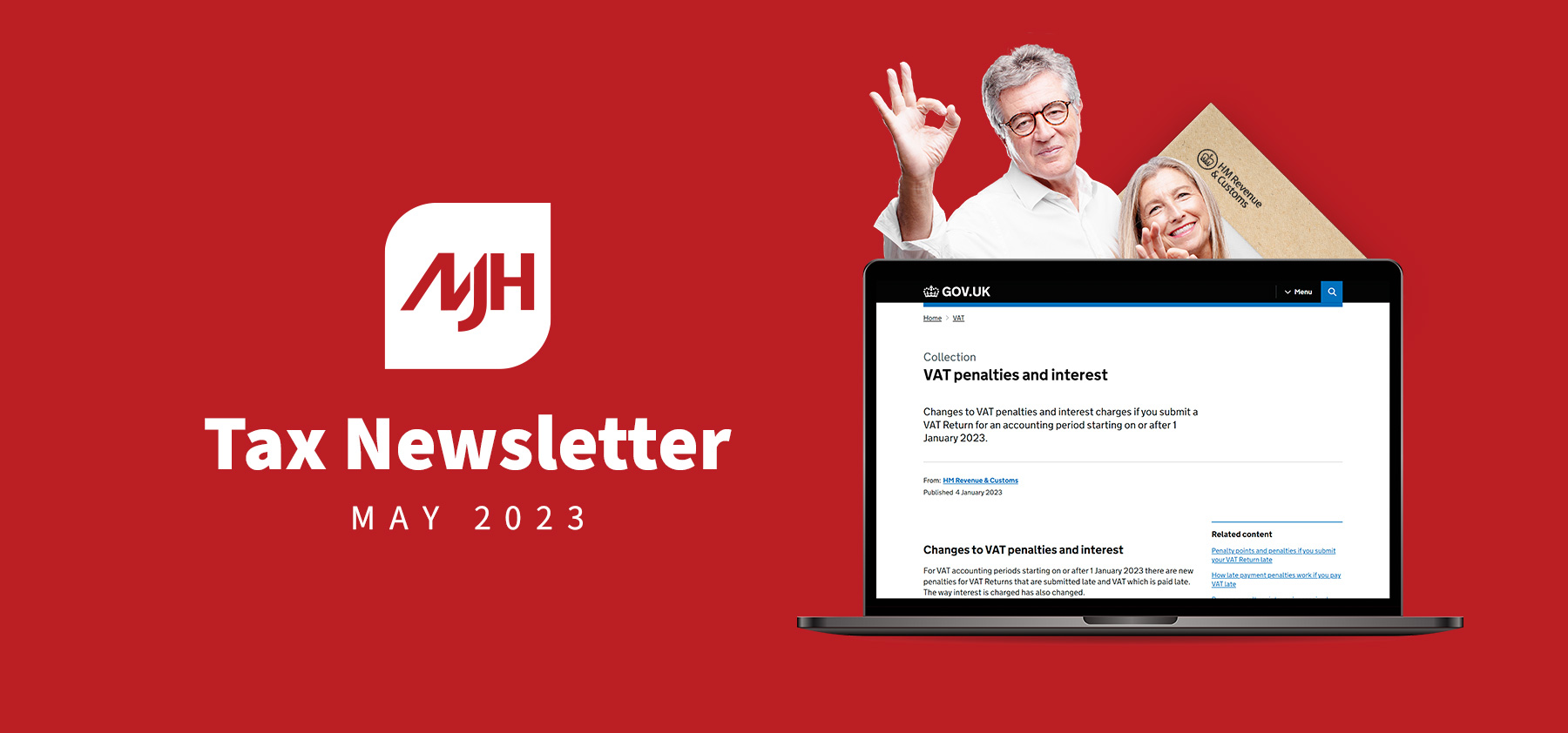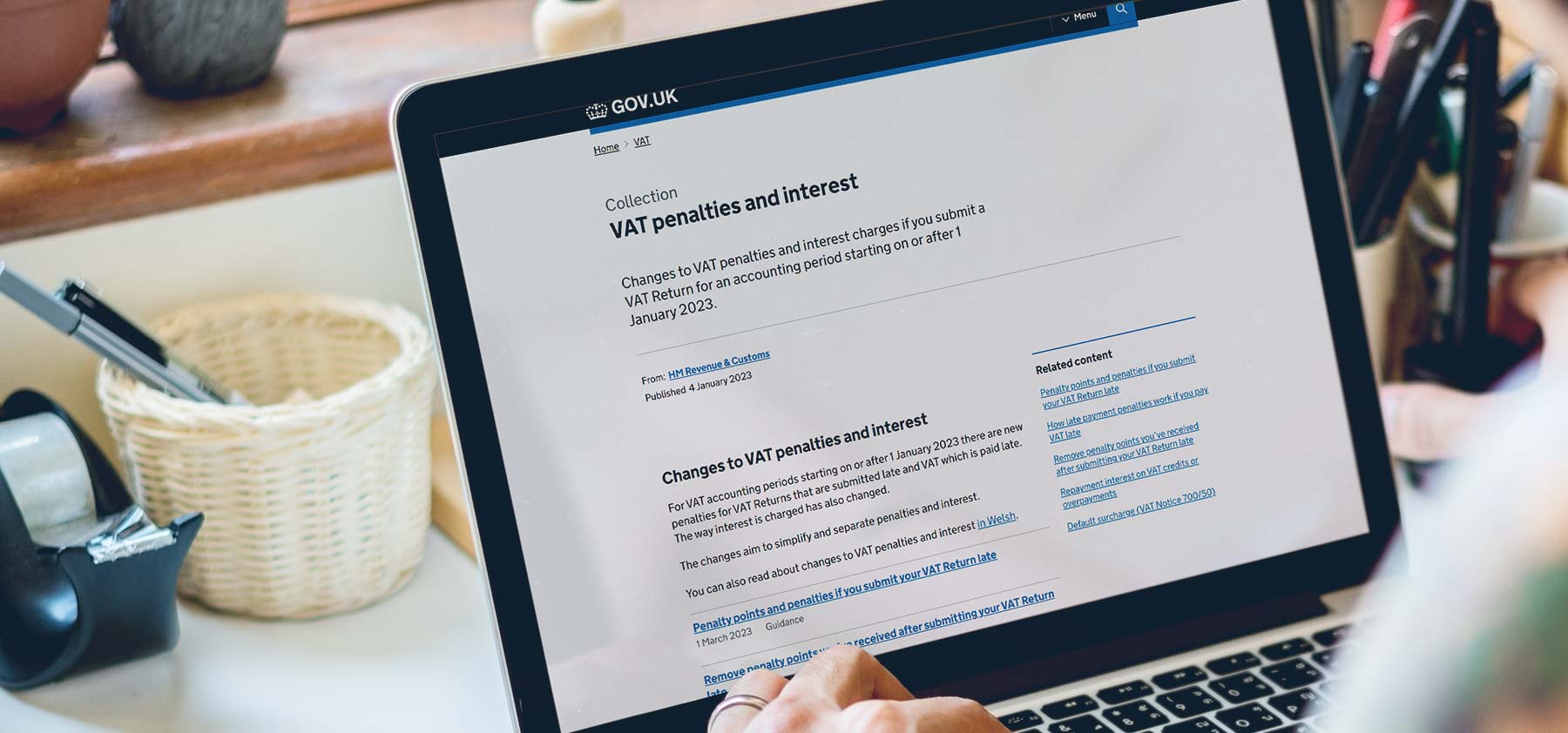
VAT penalty notices
Two new VAT penalty regimes came into effect for VAT periods beginning on and after 1 January 2023, for late filing of VAT returns and for late payment.
Late filing of a VAT return now attracts a penalty point rather than a warning or formal default surcharge notice. Only when you reach a certain threshold of points do you have to pay a fixed financial penalty of £200
The points threshold which generates a financial penalty varies according to the frequency of the VAT returns required:
– Annual returns: £200 penalty at 2 points
– Quarterly returns: £200 penalty at 4 points
– Monthly returns: £200 penalty at 5 points

Once the points threshold is reached all further late returns after that attract another £200 penalty until the points slate is wiped clean. You need to achieve full compliance for two years to wipe out points awarded for late quarterly returns.
HMRC has issued the first points for late filed monthly VAT returns. Any late quarterly returns will start to generate penalty points after 7 May 2023.
If you receive a notice about late filing penalties, check the VAT number shown matches your own registration VAT number, as the letter may not include your business name or address.
Next, check if your VAT return was submitted late and if it was, whether you have a reasonable excuse for the late filing. You can appeal against points awarded incorrectly, or where you have a good excuse.
The new late payment penalties give you a grace period of 30 days to pay the VAT due in 2023 but do your best to pay promptly as interest will be charged on late payment at 6.75% from the first day it is late.
Planning for retirement
 On 6 April 2023, the pensions annual allowance increased from £40,000 to £60,000, and the pensions lifetime allowance was effectively abolished.
On 6 April 2023, the pensions annual allowance increased from £40,000 to £60,000, and the pensions lifetime allowance was effectively abolished.
You can now contribute far more to your pension funds each year, and so can your employer. Any unused annual allowance can also be carried forward up to three years.
This freedom to contribute also applies to those with large pension savings who have fixed protection on their pension pots, to stop the lifetime allowance charge from applying. Now the lifetime allowance charge has been removed, fixed protection is irrelevant and those taxpayers can contribute more to their pension pots if they wish to.
If you run your own company, you need to consider the tax relief the company receives for the pension contributions it pays to employees. The tax deduction is only given for the accounting period in which the contributions are actually paid, the cost cannot be accrued or pre-paid.
As the corporation tax rate for companies with profits above £250,000 increased on 1 April 2023 to 25%, and a marginal rate of 26.5% now applies to profits between £50,000 and £250,000, pension contributions can be used to bring corporate profits down to the desired level.
We can help you crunch the numbers if your company’s accounting period straddles 1 April 2023.
If you are nearing retirement age you may want to start taking your pension by either annuitizing some pension pots or taking a draw-down. Annuity rates are currently high, but you should take independent pensions advice on when to convert pension savings into an annuity.
It is now easier to carry on making pension contributions once you have started to take taxable pension benefits, as the money purchase annual allowance (MPAA) has been increased to £10,000.
Finally, don’t forget to check whether you have maximized your state pension entitlement by having 35 full years of NIC. Where you have a gap in your NIC record since April 2006 you can pay voluntarily class 3 NIC to fill that gap, but you must make the voluntary payment by 31 July 2023.
Payroll settlement agreements (PSA)

A payroll settlement agreement (PSA) is used by employers to declare and pay the tax and NIC due on benefits that they don’t want the employee to be taxed on.
These may be one-off benefits paid on an irregular basis, such as the use of a company flat for a short period, or a holiday. The PSA can also be used where the value of the benefit exceeds the statutory exemption, such as for taxi fares, non-trivial gifts, or a staff party that exceeded the allowance of £150 per head.
The cost to the employer of using a PSA is significant, as the tax and NIC due on the benefit must be grossed-up. For a taxpayer who pays income tax at 45%, the tax and NIC can amount to 107% of the value of the benefit provided. However, this cost needs to be set against the savings in administrative time and employee goodwill.
Until recently the PSA had to be arranged using the form P626 and entered into no later than 5 July following the tax year for which the PSA relates.
On 6 April 2023, HMRC launched a new online service to apply for a PSA. Beware of using this service as it appears to be quite insecure. All that is needed to apply is the name and address of the business plus a telephone number and the PAYE reference number.
If you do use this new online facility to apply for the PSA, the finalized agreement will be sent by post, although you will get a confirmation of your application by email.
The tax and NIC due under the PSA must be paid by 22 October following the tax year it refers to. When making this PSA payment you must use the 14-character charge reference number shown on the pay slip sent by HMRC. This always begins with the letter ‘X’, for example, XB013456798712.
Payroll hygiene

It is very irritating when HMRC accuses you of owing more PAYE than is actually due. This can happen when the HMRC computer has recorded a duplicate employment for an employee, without ceasing the previous employment.
For example, William Smith is employed and is paid a regular salary of £2,000 per month. On the first FPS, he is recorded as William Smith. On a later FPS, he is recorded as Bill Smith. The HMRC computer will assume that William Smith and Bill Smith are two different people.
As the employment record for William Smith has not been closed the HMRC computer will generate a PAYE charge for both William and Bill on the basis that the employer has paid out £4,000 in salary that month.
HMRC has recently provided tips on how to avoid duplicate employment records:
– Use consistent employee names.
– Only include the start date on the first FPS when a new employee joins, do not alter that start date later.
– Use a unique payroll number for each employee.
– Do not reuse employee numbers.
– If an employee rejoins your payroll after leaving, give that person a new payroll number, and reset their year-to-date payment information to zero.
– If one person works two jobs for the same employer on two different payrolls, make sure that person has a different payroll number on each payroll.
– Use the ‘irregular payment pattern’ indicator for any employee who is paid infrequently.
Where new payroll software is used for the first time, or payrolls are merged, meaning new payroll numbers are issued for employees, the payroll ID ‘change indicator’ must be used. HMRC also recommends that the employer:
– Enter the previous payroll number into the ‘Old’ field.
– Enter the new payroll number into the ‘New’ field.
If an incorrect PAYE charge does arise you need to first contact the HMRC employer helpline: 0300 200 3200. If the helpline can’t fix the problem, ask for the issue to be referred to HMRC’s charge resolution team.
May Questions and Answers

Q1. The payroll for my business has increased during 2022/23, so the employer’s NIC bill topped £100,000 for the first time. Does this mean I can’t claim the Employer’s Allowance for 2023/24? Is there anything I can net off against the NIC liability to bring it down below the £100,000 threshold?
A: You are correct that you will not be able to claim the Employer’s Allowance of £5,000 for 2023/24 as your employer’s NIC liability for the previous tax year (2022/23) has equalled or exceeded £100,000. There is no mechanism for setting off any other liability to reduce the total of the Employer’s NIC for this calculation. However, you shouldn’t include any employer’s NIC on “deemed payments” to contractors caught by the off-payroll working rule.
Q2. Can I invest £100,000 on behalf of my company in a new savings account designed for individuals, to take advantage of a higher interest rate? I plan to return the capital plus all interest directly to the company’s account.
A: You can do this, but you need to be honest with the bank that the company is the ultimate owner of the funds, and you are acting as a nominee for the company for that account. Transfer the money directly from the company’s account into the new savings account and do not mix it with any private savings.
The company’s board of directors should document what is happening to the funds and approve the transfer. This needs to be made clear that the transfer is not a loan to yourself as an individual. Taking a loan from your company that remains outstanding for more than 9 months after the company’s year-end will trigger a Section 455 tax corporation charge, and a beneficial loan charge for you personally.
Q3. My father died suddenly so his sole-trader business ceased at that point. I am the executor of his Will and I appointed a solicitor to collect the debts due on his outstanding sales invoices after his death. The business was taxed on a cash basis. How should I account for the sales income and expenses received after the business ceased?
A: As your late father used the cash basis all the business expenditures paid out and sales income received before his death should be reported on his personal tax return drawn up to the date of death.
The cash received for the business after the date of death should be reported by you as executor of the estate on a tax return for the estate. The costs of collecting those sales debts are deductible against that sales income.
May key tax dates

1 – Where the taxpayer has not submitted their 2021/22 self-assessment tax return by midnight the following penalties apply:
for online filing – £10 daily penalties
for filing on paper – the greater of £300 or 5% of the tax showing on the return.
3 – Employers must submit the form P46 (Car) to HMRC for employees who have been provided with a company car for the first time during the quarter to 5 April 2023.
31 – Employers must provide a form P60 for 2022/23 to those employees who they employed on 5 April 2023.
Returns under the Crown Dependencies and Overseas Territories reporting rules due for the year to 31 December 2022.
FATCA returns must be submitted to the IRS for the year to 31 December 2022
 Book a No-obligation Call or Meeting
Book a No-obligation Call or Meeting




 Book a Call or Meeting
Book a Call or Meeting

